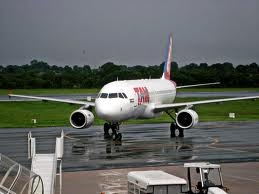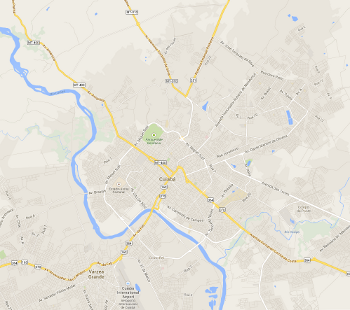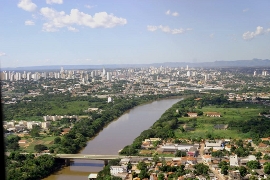Overview

State Flag of Mato Grosso
Cuiabá is an island of civilization in the middle of the interior of Brazil. Most of the interior is still lightly-settled, with few major highways to connect the widely-scattered cities and towns. Most of the other cities in the region are much smaller. The region is largely open, with sparse trees and no actual forests. Major highways connect Cuiabá with the east, west and south, and a smaller highway leads up to the high country around Chapada dos Guimarães.
The region is volcanic in origin, and surrounded by elevated country more than 500 meters higher, and consequently notably cooler. Although agriculture is extensive in the state of Mato Grosso, there is actually very little in Cuiabá and the immediate surrounding area. Rather, the economy is based on commerce, service and industry, with a large industrial park sector hosting many agribusinesses.
The city is largely modern, with mostly paved streets except in a few outlying areas. In 2012, much major construction began with the goal of upgrading the infrastructure in preparation for hosting games for the World Cup in 2014. This upgrading included building a light-rail system from the airport in Várzea Grande all the way through Cuiabá itself. And a lot of the road construction was aimed at improving the main perimeter highway, which is used for rapid transport around the major areas of the city.
Cuiabá is also noted for the local accent. Cuiabanos use words and expressions—and often pronounce other words and expressions—in their own unique way. Sometimes even fellow Brazilians from other parts of the country have some difficulty understanding a thick cuiabano accent. There is a book called Dicionário Cuiabanês, which is sort of pokes tongue-in-cheek fun at the local accent, in a manner reminiscent of How to Speak Southern in the United States.
Overall, Cuiabá is not a bad place to live, if you like large cities and can stand the heat (see the next section about the climate). Unfortunately, the crime rate is rather high. But the city is relatively clean, and goods and services are readily available that are not found in most smaller towns.
Climate
There is a joke that goes as follows: A “bad” cuiabano died and ended up in Hell. Looking around, he smiled and said, “Ah! Air conditioning!”
Although there are other parts of Brazil where the temperatures are just as unpleasantly high, Cuiabá is the place that is famous for heat. Probably one factor that helps maintain this reputation is the fact that, unlike in places such as Porto Velho, it does not cool down much at night. Without the jungle vegetation to provide the natural equivalent of evaporative cooling, the air retains its heat.
Nevertheless, in spite of being notably hotter than places such as Brasília and Anápolis, Cuiabá is subject to friagens during the winter months, which can actually produce days colder than in either of those two cities. Because the population is so accustomed to the regular blast furnace climate, many local residents suffer considerably during these cold spells.
Although I just used the word “winter” in reference to seasons, it is more common to think in terms of Rainy Season and Dry Season, rather than in the traditional four seasons that people in more temperate climates are familiar with. Rainy Season is just that: rainy. Expect cloud build-ups every day, usually resulting in thunderstorms. But the rain is seldom refreshing; the falling drops are still warm. About the only thing that the rain does is causes vegetation to grow and settles any dust that might still be hanging in the air. At times the rain can be so intense that small streams can overflow their banks and even wash away bridges.
Dry Season, which usually begins around May, give or take, is marked by the near total absence of rain. Days are either cloudless from sunup to sundown, or at most there is some build-up which produces nothing. The ground dries into powder. Grass turns brown. Dust hovers in the air whenever vehicles pass by. The heat continues, often even worse because even the warm rain of Rainy Season has a mild cooling effect, and is absent now. Fortunately, from time to time one of the friagens mentioned above will come through, often bringing rain without thunder and lightning, along with sharply cooler days and nights.
Often, especially in August and September, comes what is known as “Smoke Season”. This is the time when many farmers clear their land by burning the previous year's fields. This results in a pall of smoke that fills the air for weeks. The sun is often reduced to a bleary orange disk in the ash-gray heavens. Respiratory irritation becomes acute, and some people even go around wearing surgical masks. Even the airport has been closed at times because of extreme visibility limitations. Fortunately, Smoke Season generally ends with the first preliminary rains at the beginning of Rainy Season.
Transportation
Like any other Brazilian city of any size at all, Cuiabá has a good urban bus system. You can get just about anywhere in the city you want, riding the bus. The main trick is knowing the city well enough to know which bus to take, and to know when you are approaching your destination, so that you remember to signal the driver that you wish to get off.

As mentioned above, Cuiabá and Várzea Grande are surrounded by a perimeter road, which is divided and with fewer traffic lights than most of the city. Most people who want to get from one part of town to the other take the perimeter road if possible. There are also several major arteries passing through the city itself, such as Avenida Fernando Correa and the main downtown avenue commonly called the Prainha. Being a large city, there is a lot of car traffic. But the street layout is fairly well done, and except for times of major road construction, you can get from one place to another in a reasonable amount of time.
With few exceptions—mainly a few outlying sectors that were “out in the country” not that long ago—the city streets are paved and fairly well maintained. And as with most Brazilian cities, speed bumps abound. (In most cases, it is the only way to get a lot of drivers to slow down!)
Cuiabá also boasts the Marechal Rondon International Airport, with flights to many domestic destinations, as well as a few international flights to some other South American countries.
And, like just about any other Brazilian city, Cuiabá has a rodoviária, or inter-city bus station. Here, you can get tickets to many other cities in the country. And if there is no bus to your particular destination, you can get a ticket to another city where you can transfer to a bus that will get you there.
Shopping and Services

Map of Cuiabá
There are at least three full-sized, fully modern shopping centers in Cuiabá: Shopping Três Américas, Shopping Goiabeiras and Shopping Iguatemi. Each mall has multiple floors, many stores, a covered parking garage, and a food court with many restaurants. City buses will take you to each one of them. In addition, the city abounds with stores of all varieties, big and small, restaurants of many types, and lots of services.
A number of grocery stores, both individual and chains, provide service in Cuiabá. Modelo is one of the older chains. A newer supermarket, which arrived in the area in the late 1990's, is called Big Lar (an interesting combination of English and Portuguese). Big Lar is noted for its large selection and availability of items that often cannot be found in other stores, such as jalapeño peppers, Mexican hot sauce and chili powder.
You can find several good churrascarias; restaurants where waiters come around and serve various types of meat on spits, and where you can also take your plate to a food bar and heap it full of whatever you can find there. (It is difficult to go to a churrascaria without coming away feeling very full!) There are also good all-you-can-eat pizza places, and a lot of weigh-your-plate restaurants, which are popular in Brazil.
Cuiabá has very good Internet service. This is because at one time, when they were upgrading the main trunk lines into the region, someone was far-sighted enough to realize that data transmission was going to grow by leaps and bounds, and convinced the Powers-That-Be to build for the future. The result was a data infrastructure capable of handling very large volumes of traffic, well ahead of its time.
In the early 1990's, telephone service was terrible, as was the case in much of the country. You held the receiver up to your ear, plugged the other ear, and hoped you could hear what the person on the other end of the line was saying. If you wanted a new phone line, you paid upwards of US $1000, and in a couple of years would actually get your new line. All that changed in the mid-90's when privatization came along (more evidence that government monopolies are a terrible idea). Today, you pay a very reasonable fee of less than US $100 for a new line, and it is usually available in a few days at most. You can call long-distance and hear the other party as clearly as if they were standing next to you. Cell phone service is everywhere, with multiple providers. All in all, very modern.
There are a lot of computer stores, where you can find everything from new computers to parts to software to networking equipment to just about whatever you want. Some stores specialize in specific areas of information technology. There is also a shop which will refill LaserJet cartridges and do a very professional job, for a reasonable cost.
Water and electricity are also fairly reliable.
SIL Presence and Activity
For many years, SIL Brazil maintained an extensive translation center in Cuiabá, located in the Coxipó da Ponte sector of the city. A rural environment, the Cuiabá center contained administrative and service facilities, plus housing for members and indigenous helpers who came to the center for various activities. An airstrip and hangar provided flight service capability. The center had its own internal electrical grid, water system and phone network.
For most of its existence, the Cuiabá center primarily served translators and related support work. However, in the mid-1990s the SIL Brazil administration elected to close what was then the organizational headquarters in Brasília and moved them to Cuiabá. As a result, additional buildings were constructed for both administration and the increased population that resulted from the move. Nevertheless, in spite of the addition of the organizational administrative headquarters, the Cuiabá center continued its primary task of supporting translation work.
In the middle of the first decade of the 21st century, declining membership and shifting focus led the administration to move its headquarters once again, this time to Anápolis. In addition, it was becoming evident that the infrastructure was old and in need of major repairs if the center were to remain viable. So the decision was made to completely close down the center and sell the land to a local developer who had been wanting to buy it for years. The one remaining translation project that still needed to operate out of Cuiabá moved to a nearby house, and a support couple moved into a house next to them, until their project was completed.
Today, although there is no longer an official SIL presence in Cuiabá, a couple of translation teams work out of either the city itself or else another nearby town.
The AMMI Bible School
The AMMI Bible School (“AMI” in Portuguese; the name comes from the Hebrew word for “my people”) is actually located near the small town of Chapada dos Guimarães, some 50 kilometers away. However, over the years there has been much interaction between SIL and AMMI, including having a few SIL members working there recently. And while the SIL Cuiabá center existed, AMMI workers sent many of their children to the center school for their education. In addition, a purely indigenous organization, CONPLEI, has offices on the AMMI center, and also partners with SIL in linguistic training.
AMMI is a school for indigenous students, and is run by South America Mission. The purpose of the school is to train indigenous Christians to understand and use the Bible, both in their personal lives and as church leaders among their own people. Although Portuguese is of necessity used in the classroom, students are encouraged to study scripture and teach in their own languages.
On the AMMI center you will find a number of residences for members, as well as a large multi-use building and smaller classroom buildings. Students live in dormitory-style housing, and a dining hall serves meals for students and other short-term visitors. A sports court provides recreational opportunities.
The courses at AMMI are not free. Some kind of income is necessary in order to maintain the facilities, and charging for the privilege of studying adds incentive for students to “get their money's worth” and make serious efforts to learn.
The climate is several degrees cooler than in Cuiabá, and there is more rain. Due to the altitude (the Chapada sits several hundred meters higher than the plains of Cuiabá), mist and fog are fairly common. So is lightning, and electronic equipment must be protected to avoid damage. During Dry Season—which is also winter—cold fronts can drop the temperatures into the 30's and 40's (Fahrenheit). Students from regions in the Amazon that never truly experience winter temperatures find this quite unpleasant.
Electricity is moderately reliable, though not as much so as in Cuiabá. Water is provided through a well. In Dry Season, the water table drops considerably, and it is not uncommon to have to ration water use, especially when there are a large number of people on the center. Internet service is via radio connection from the town of Chapada dos Guimarães, and not terribly great. Unfortunately, there is only one provider.
Area Tourism
Cuiabá has often been called the “gateway to the Pantanal”. The Pantanal is a large, swampy region a ways south of the city which is noted for eco-tourism, and Cuiabá has the closest airport and easiest access. Tour packages are available which include transportation, guides and lodging.
Another relatively nearby attraction is the Chapada dos Guimarães. The city of the same name offers a five-star hotel and a lot of local tourist items. In addition, there is the national park, just off the higway from Cuiabá a little ways before you get to the city. Parque Nacional Chapada dos Guimarães has hiking trails and water activities (on a small scale). Since the entire high country of the Chapada is split by a river canyon, the park offers many excellent views. In addition, although there are no forests in the lowlands of Mato Grosso in the Cuiabá region, many parts of the Chapada are well-forested, including the park.



